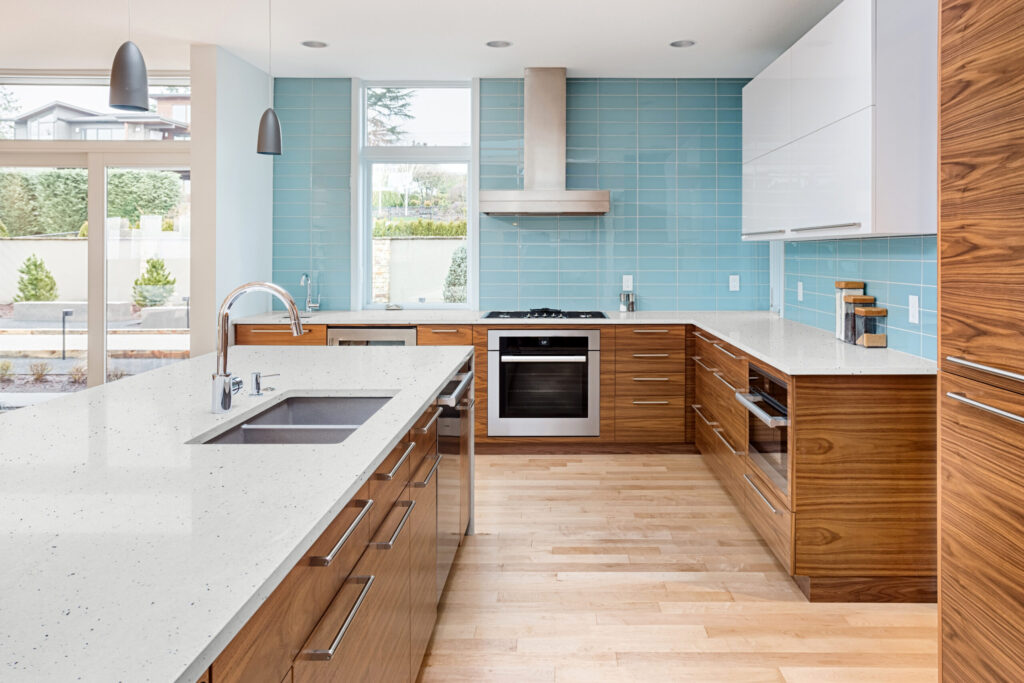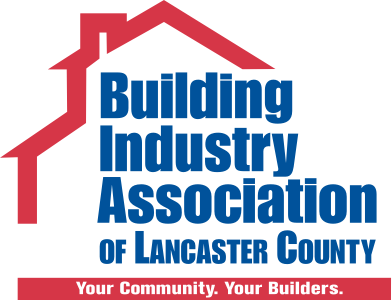Kitchen remodeling trends in 2025 reflect a shift toward personalized spaces that blend functionality with individual style. Homeowners move beyond cookie-cutter designs, choosing materials, colors, and layouts that express their unique personalities while maximizing everyday usability. These emerging trends balance timeless appeal with contemporary innovation, creating kitchens that feel both current and enduring.
Lancaster Kitchen and Baths tracks the latest design movements to bring cutting-edge ideas to every kitchen remodeling project. Our expertise in current trends helps homeowners make informed decisions that add value and enjoyment to their homes. From bold color choices to innovative storage solutions, we incorporate 2025’s top trends into practical designs that work for real families.
Bold Color Palettes Replace All-White Kitchens
The dominance of white kitchens gives way to rich, saturated colors that create visual interest and warmth. Deep navy blues, forest greens, and charcoal grays appear on cabinetry, creating sophisticated backdrops for daily life. These darker tones provide depth while hiding everyday wear better than lighter colors.
Two-tone designs gain popularity as homeowners combine colors for dynamic visual effects. Upper cabinets in light shades paired with darker base cabinets create the illusion of higher ceilings. Island cabinets in contrasting colors become focal points that define spaces within open floor plans.
Colorful backsplashes make dramatic statements in 2025 kitchens. Jewel-toned tiles, patterned ceramics, and textured materials add personality without overwhelming spaces. These accent features allow easy updates as tastes change, protecting larger investments in cabinetry and countertops.
Natural Materials and Organic Textures
Wood returns to kitchens in unexpected ways beyond traditional cabinetry. Live-edge countertops on islands create conversation pieces that celebrate natural beauty. Wooden backsplashes treated with protective finishes bring warmth to contemporary spaces. Open shelving in various wood tones adds texture while displaying cherished items.
Stone surfaces expand beyond typical applications. Full-height stone backsplashes create seamless transitions from countertops to walls. Natural stone sinks carved from single blocks become sculptural elements. Textured stone finishes like leathered or flamed granite offer alternatives to polished surfaces while maintaining durability.
Organic patterns influence everything from tile designs to cabinet hardware. Botanical motifs, flowing curves, and irregular edges soften the hard lines typical in kitchens. These natural elements create calming environments that connect indoor spaces with outdoor views.
Mixed Metal Finishes Create Visual Depth
The rule about matching metals becomes obsolete as designers intentionally mix finishes for layered looks. Brass faucets pair with black cabinet hardware, while copper accents complement stainless steel appliances. This trend allows gradual updates without replacing everything at once.
Warm metals like brass, copper, and gold make strong comebacks in 2025. These finishes add richness to both traditional and contemporary designs. Unlacquered versions that develop patina over time appeal to homeowners seeking authentic, evolving materials.
Black metal finishes provide dramatic contrast in light-colored kitchens. Matte black faucets, range hoods, and light fixtures create focal points without overwhelming spaces. This versatile finish works with virtually any color palette, making it a safe choice for long-term satisfaction.
Smart Storage Solutions Maximize Every Inch
Drawer organizers become increasingly sophisticated with custom inserts for specific items. Pegboard systems allow infinite adjustability as needs change. Divided sections for utensils, spices, and small appliances keep everything visible and accessible without rummaging.
Pantry designs evolve beyond simple shelving. Pull-out drawers replace fixed shelves for better visibility and access. Temperature-controlled zones preserve different foods optimally. Glass doors or open designs showcase organized spaces while encouraging tidiness.
Corner solutions finally solve the challenge of awkward spaces. Rotating shelves, magic corners, and diagonal drawers make every inch functional. These innovations eliminate the need to crawl into cabinets or lose items in dark recesses.
Integrated Breakfast Nooks and Casual Dining
Built-in seating maximizes space efficiency while creating cozy gathering spots. Banquettes with storage underneath serve double duty in smaller kitchens. These integrated breakfast nooks become favorite spots for homework, casual meals, and morning coffee.
Multi-level islands accommodate both food prep and dining. Raised bar sections provide casual seating without interfering with cooking activities. Waterfall edges on the dining side create finished looks while protecting cabinets from spills and scuffs.
Flexible dining solutions adapt to different occasions. Extending tables built into islands accommodate extra guests when needed. Drop-leaf sections fold away when not in use. These adaptable designs support both intimate family dinners and larger gatherings.
Statement Lighting as Functional Art
Oversized pendants become sculptural elements that define spaces. Single dramatic fixtures replace multiple smaller lights over islands. These statement pieces provide both task lighting and visual interest, serving as jewelry for the kitchen.
Layered lighting schemes address different needs throughout the day. Under-cabinet LEDs illuminate work surfaces without shadows. Toe-kick lighting provides safe navigation during nighttime visits. Dimmable fixtures create ambiance for entertaining.
Architectural lighting highlights design features. Cove lighting emphasizes tray ceilings, while LED strips showcase glass-front cabinets. These subtle additions create depth and interest without cluttering sight lines with visible fixtures.
Sustainability Drives Material Choices
Recycled and reclaimed materials gain prominence in 2025 kitchens. Countertops made from recycled glass or paper composite offer unique aesthetics while reducing environmental impact. Reclaimed wood for islands or accent walls adds character with compelling backstories.
Energy efficiency influences every decision from appliances to windows. Induction cooktops reduce energy consumption while providing precise temperature control. Triple-pane windows minimize heat loss without sacrificing natural light. LED lighting throughout reduces electrical usage dramatically.
Water conservation features become standard rather than optional. Low-flow faucets with aerators maintain pressure while reducing consumption. Dishwashers with soil sensors adjust water usage based on actual needs. These features save resources without compromising functionality.
Open Shelving and Display Storage
Open shelving continues trending but with more thoughtful implementation. Floating shelves in natural wood or metal complement closed storage rather than replacing it entirely. Strategic placement near windows or light sources creates bright, airy feelings.
Glass-front cabinets offer compromise between open and closed storage. Reeded or textured glass provides visual interest while partially concealing contents. Interior lighting transforms these cabinets into display cases for special dishes or glassware.
Mixed storage approaches balance aesthetics with practicality. Open shelves display attractive items while closed cabinets hide everyday necessities. This combination prevents kitchens from feeling cluttered while showcasing personality through curated displays.
Texture-Rich Surfaces Add Dimension
Textured tile backsplashes create visual and tactile interest. Three-dimensional patterns, raised designs, and varied surface treatments catch light differently throughout the day. These dynamic surfaces add movement to otherwise static spaces.
Cabinet doors feature more elaborate profiles and textures. Reeded glass, cane webbing, and carved details return to fashion. These elements add craftsmanship and visual weight that flat-panel doors lack.
Mixed textures within single spaces prevent monotony. Smooth countertops contrast with rough stone backsplashes. Glossy tiles play against matte cabinet finishes. These juxtapositions create sophisticated, layered designs.
Professional-Style Appliances for Home Chefs
Restaurant-inspired equipment becomes more accessible for residential use. 48-inch ranges with multiple ovens support serious cooking endeavors. Steam ovens add versatility for health-conscious preparation methods. Built-in sous vide drawers bring professional techniques home.
Refrigeration expands beyond single units. Dedicated beverage centers, wine storage, and drawer refrigerators create specialized zones. Under-counter units in islands keep ingredients close to prep areas. This distributed approach improves workflow and reduces congestion.
Ventilation systems match increased cooking capabilities. Powerful range hoods with quiet operation become necessities rather than afterthoughts. Make-up air systems prevent negative pressure issues in tightly sealed homes. These professional-grade systems support ambitious culinary pursuits.
Industry Standards and Guidelines
The National Association of Home Builders (NAHB) reports that kitchen remodeling remains the most popular home improvement project for 2025, with homeowners prioritizing functional upgrades alongside aesthetic improvements. Their research shows that well-designed kitchens return significant value at resale while improving daily quality of life.
The American Institute of Architects (AIA) identifies sustainability and wellness as driving forces in 2025 kitchen design. Their guidelines emphasize natural lighting, improved air quality, and ergonomic layouts that support healthy lifestyles. Following these principles creates kitchens that nurture both physical and mental well-being.
Bring 2025’s Best Trends to Your Kitchen
The top kitchen remodeling trends of 2025 offer exciting possibilities for creating personalized, functional spaces. Lancaster Kitchen and Baths helps homeowners navigate these options, selecting trends that align with their lifestyles and design preferences.
Our design team understands how to incorporate trending elements while maintaining timeless appeal. We balance current fashions with practical considerations, creating kitchens that feel fresh today and remain relevant for years.
Ready to explore how 2025’s trends can refresh your kitchen? Contact our design experts to discuss which innovations best suit your space and lifestyle.
Frequently Asked Questions About 2025 Kitchen Trends
Which 2025 kitchen trends offer the best long-term value?
Natural materials like stone countertops and hardwood elements typically maintain appeal across changing fashion cycles. Smart storage solutions and energy-efficient appliances provide ongoing functional benefits regardless of aesthetic trends. Mixed metal finishes offer flexibility for future updates without complete overhauls. Focus on quality materials and improved functionality rather than purely decorative elements for lasting value.
How can I incorporate trends without complete renovation?
Start with easily changeable elements like cabinet hardware, light fixtures, or backsplashes. Paint existing cabinets in trending colors for dramatic impact at minimal cost. Add open shelving or glass inserts to select upper cabinets. Update faucets and fixtures in trending finishes. These smaller changes can modernize kitchens without major construction.
Do dark kitchen cabinets make spaces feel smaller?
Dark cabinets can actually make spaces feel larger when paired with adequate lighting and lighter complementary elements. The key lies in balancing dark lower cabinets with lighter uppers or walls. Reflective surfaces like glossy backsplashes or metallic accents prevent heavy feelings. Proper under-cabinet lighting eliminates shadows that might otherwise make spaces feel cramped.
What’s the typical timeline for kitchen trends to change?
Major kitchen trends typically last 7-10 years, while smaller decorative elements change every 3-5 years. Classic elements like natural wood and stone remain stylish across multiple trend cycles. Color preferences shift more frequently than material choices. Planning renovations around enduring elements while using accessories for trending touches provides the best longevity.
How do I choose between trending and timeless design elements?
Invest in timeless elements for expensive, difficult-to-change features like countertops, flooring, and cabinetry boxes. Apply trends through more easily updated elements like cabinet doors, hardware, backsplashes, and paint colors. This approach allows kitchen refreshes without complete renovations as preferences evolve. Work with experienced designers who understand which trends have staying power.





